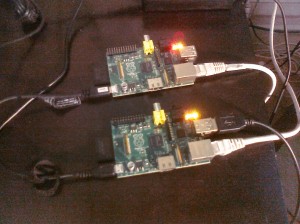So in my last post, I wrote about the setup of my little CryptoCoin mining experiment, and in this post I am presenting the results. But before I jump into the results, I want to discuss some of the assumptions and biases of this experiment:
Bitcoin and Litecoin both adjust the difficulty of their proof-of-work problems in order to throttle the mining process and keep the additions to the block chain occurring at a regular, predetermined rate. The difficulty changes frequently, and over the course of the experiment, the difficulty for both Bitcoin and Litecoin increased significantly. This means that the rate of coin mining most likely got a good deal slower as the experiment progressed. Unfortunately I did not collect interval data, I only have overall results, so I cannot quantify the impact (would make an interesting follow on, perhaps I will do it later). If you attempt to recreate this test, your results will vary significantly due to this issue.
In addition to the variable difficulty, each mining pool has it’s own issues. Both mining pools would go down from time to time (this is pretty common). Unfortunately, when the Bitcoin pool would go down, the miner on the RasPi would shutdown. I did my best to check regularly and restart the miner (apparently there are ways to have the miner automatically switch to a backup pool), but there were definitely a few times when it went down for more than a day. The impact is probably in the range of 10-20%, meaning had I taken better measures to protect against downtime, I most likely would have seen an increase in Bitcoin returns by 10-20%.
The final consideration to make, is that the value of the respective coins is constantly changing. I used $127.53 for Bitcoin and $2.86 for Litecoin. These were the prices of the coins on the day I stopped the experiment. The exchange rates vary wildly, and as such, your results will depend heavily on the current exchange rates.
So let’s get down to it. The experiment lasted 42.1 days (I let the miners run for a bit longer than I initially had planned). The following table presents the number of coins mined and the dollar value of those coins:
So as was expected, the RasPis mined much more Litecoin than Bitcoin over the course of the 42 days. This is due to the popularity, and subsequently difficulty, of mining Bitcoin. Interestingly enough, while we mined 2x orders of magnitude of Litecoin, due to the exchange rates of the coins, the monetary value of the coins was much closer.
Another factor that needs to be taken into account is the cost of electricity. While, I am currently using the RasPis as servers and development/test boxes, if I wanted to use the RasPi as a dedicated mining rig, than I would need to adjust the returns for the cost of electricity required to run the device (while RasPis are really low powered, if you were running a dedicated GPU rig, electricity costs would be a very important factor to consider). After digging around on the internet I came up with a rough estimate of the energy consumption of a RasPi. Interestingly enough, the RasPi seems to have fairly stable power consumption regardless of the amount of processing it is doing (a testament to the efficiency of the ARM processors?). I rounded the power consumption up to 3 watts (from 2.5) to keep things conservative. Below is a breakdown of the costs, the electricity rate was pulled from my latest utility bill:
And here is the electricity adjusted returns of the mining operation:
So as you can see, accounting for electricity costs, the miner operations for both Bitcoin and Litecoin resulted in negative returns. As I mentioned, I have the RasPis up and running for other reasons anyway, but regardless, the number of coins mined are so small that the gains are entirely swamped out by electricity costs. Just to break even, you would need Bitcoin to increase in value to ~$1950 and Litecoin to increase in value to ~$17.35. And of course, that is assuming the mining difficulty stays relatively constant, which it most assuredly won’t if the exchange rate rises to those levels.
So in conclusion, if you were hoping to set up a Raspberry Pi CryptoCoin mining rig in order to retire early, I would recommend reconsidering, or at least keep your day job! But if you have some Raspberry Pis up and running anyway, and want to play around with some of the mining software that is out there, than this is a good way to get into the game with out risking the security of your main computer (there are some pretty sketchy operators in the CryptoCoin space, so take precautions).

